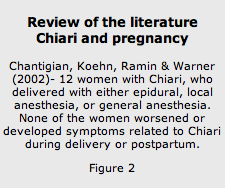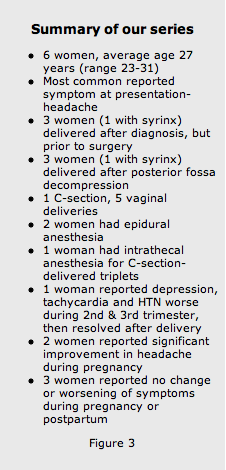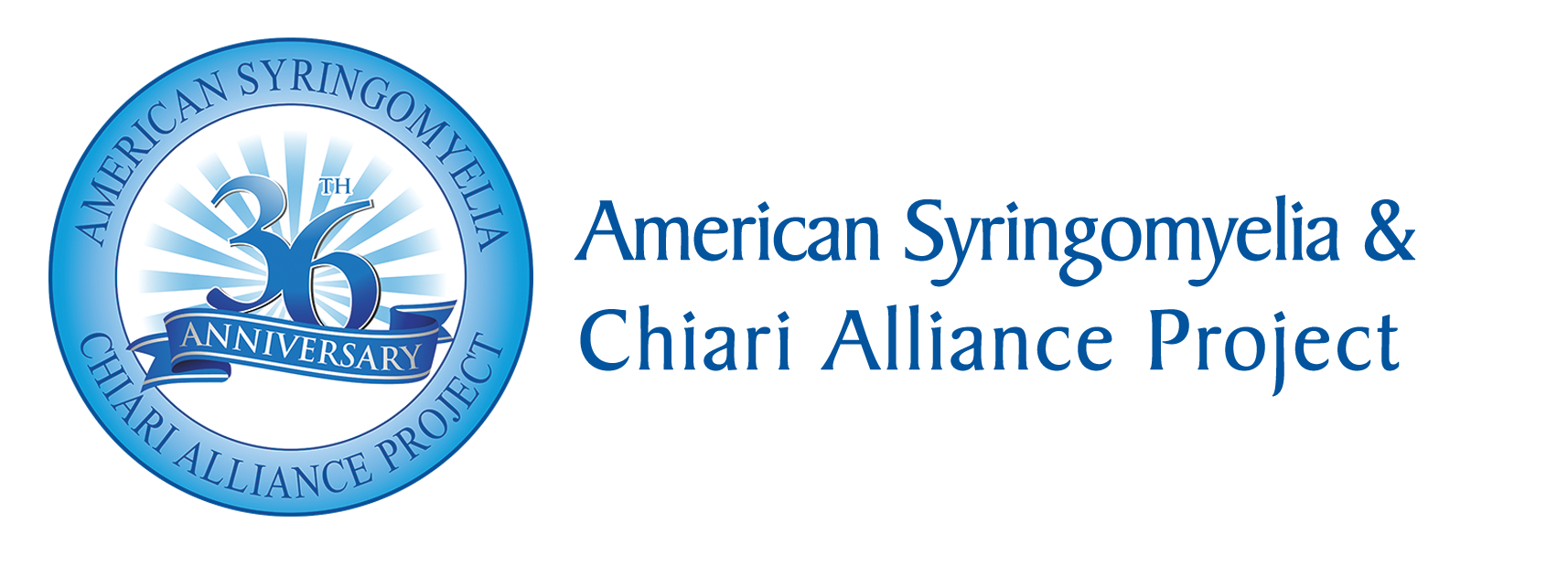Chiari and Pregnancy
click on title to view video presented by Roger Kula, MD; NSPC, Lake Success, NY
Pregnancy and Chiari Malformation with or with out syringomyelia
by Diane Mueller, ND, RN, C-FNP
The reason I became very interested in this due to the frequency of times I was having this discussion not only clinically but on the telephone or over the Internet: is it safe to plan a pregnancy when you have Chiari? Is it safe to have a vaginal birth? Should I have a c-section? I’ve even been contacted by many health care providers, asking if it safe for the patient to have a vaginal delivery. And what I found was there was very little literature to support either having a vaginal delivery or epidural.

Certainly that would make anyone be concerned about intracranial pressure or intraspinal pressure during an active phase of labor. The studies did support epidural anesthesia during contractions to control pain. So pain control during contractions was one of the most important factors in controlling CSF pressure during active labor. Once again these are patients who were studied who did not have diagnosis of Chiari or syringomyelia at the time of delivery.

The general anesthesia was for the c-section, and none of the women out of that 12 were reported either worsening or developing new symptoms either during pregnancy, during delivery or postpartum. So this was an encouraging study I found because first it was the largest case study I could find, 12 women. And it showed that there was either no new development of symptoms or worsening of symptoms and certainly no complications reported either during pregnancy or during delivery.
This is one of our beautiful baby girls who was born to a young woman in Rochester, NY. She was about 26 years old when she had her surgery; she had about a 9mm herniation and a very large cervical syringomyelia. She did very well after surgery, and the syrinx actually resolved 3 months later on MRI. This baby was born about 13 months after her decompression surgery. She did absolutely fine during her pregnancy; she had no new symptoms. She had no symptoms during labor; she labored for about 3 ½ to 4 hours, and she did have an epidural injection during labor. She had no problems related to the delivery, and has had no problems since. She did very well and as you can see normal healthy beautiful baby girl.

[see Figure 3] I don’t have time to go over each case individually, so I’d like to just summarize the 6 patients we followed prospectively during their pregnancy and talk about each in summary.
We followed 6 young women average age of 27 years, so the range of age for these folks was 23 to 31 years of age. The average amount of herniation was 8mm in this group. The most common reported symptom at presentation to us was headache, which is very typical and classic of Chiari malformation. There were 3 women, one with a syrinx who delivered after they were diagnosed with Chiari malformation but before they had surgery. These are women who had a pregnancy after diagnosis but before decompression surgery. We had 3 women, again one with a syrinx, who delivered after posterior fossa decompression. These are women who were diagnosed, had the decompression surgery and then delivered after their surgery. Of course, they were not pregnant during their surgery. We had 1 c-section and 5 vaginal deliveries. 2 women had epidural anesthesia, had absolutely no problem with epidural anesthesia, had no complications, and did not report an increase in symptoms because of the epidural anesthesia.
We had 1 woman who had an intrathecal anesthesia for a c-section. She delivered triplets. I’m going to be talking about her in just a little bit. She’s a very unique case for us and probably for most of the people who follow Chiari patients. We had 1 woman who reported depression, tachycardia and hypertension, all of which were worse during the second and third trimester of her pregnancy; however, they’ve since resolved after delivery.
It would be interesting to ask if the depression, tachycardia and hypertension were due to the pregnancy, or because of the Chiari malformation? This woman had not had surgery yet so it’s difficult to say what came first, the pregnancy that caused this or the Chiari malformation that aggravated it. We had 2 women who reported significant improvement in their headaches during pregnancy. It’s hard to explain that if the intracranial pressure and the intraspinal pressure increased. It’s hard to explain how the headache actually improved during pregnancy, but these are self-reported symptoms that had improved.
We then had 3 women who reported no change or worsening of their symptoms during pregnancy, during delivery or postpartum. When we looked back through our series, of a little over 300 patients, we did note that quite a few of the patients had reported either their symptoms starting during a pregnancy, starting during delivery or starting shortly thereafter. And in looking a little bit closer at these, these are 12 additional patients, these are not out of those 6, those 6 are in addition to. We had 2 whose headaches began during the pregnancy; they can actually remember, “Gosh, I was fine up until I was pregnant with my second child. All of a sudden I started having symptoms.” We had 3 patients whose headache was worse during the pregnancy. In other words, they had the headache prior to pregnancy, but for some reason the symptoms became worse, and that was the 3 out of those 12.
We had 5 patients who said their headache became significantly worse after epidural anesthesia for vaginal delivery. We had 1 patient who had a headache that became worse after delivery but not an epidural anesthesia, so for some reason the intracranial pressure increased and the headache became worse. And then we had 1 patient whose headache recurred. She had already been decompressed, had a decompression procedure, by the way, not with us. Her headache recurred after her first pregnancy. So she had Chiari malformation decompression and then her headache did recur after her first pregnancy and that again was a little bit different.
A couple of conclusions that we can draw and certainly by no means are there conclusions based on every individual patient, if you’re planning a pregnancy, you need to talk with your individual providers and make sure that they understand Chiari, that they understand syringomyelia and that they understand that complications can present themselves.
In our series with these 6 patients, we had no patients who reported significant increase in symptoms during and after delivery. We had no complications of epidural anesthesia as related to Chiari. Now that’s not to say patients didn’t have a wet tap and have to have a blood patch afterwards. These are symptoms related directly to Chiari, whether they had previous surgery or not.
Again, the true risk of intracranial pressure or intraspinal pressure with intrathecal or epidural anesthesia really remains uncertain. I could not find in the literature any case reports that specifically stated there was a problem with vaginal delivery, epidural anesthesia or intrathecal anesthesia related directly to Chiari; and in our series, we had none. But again, it’s important to talk with your provider about the Chiari malformation. Make sure your OB/GYN understands the disorder, understands the complications that could arise, and you can share this information with that person.
Just to look at a couple of other little babies who have been born. This is a wonderful little baby who was born in Missouri. Mom had a normal vaginal delivery, had no problems during pregnancy and certainly no problems during delivery, and as you can see, it’s a normal healthy little girl.
And this little one, you can see has no problems with laughing, laughing doesn’t cause her any problems with headache, and any picture you see she is laughing just like that, so, fortunately, normal healthy babies that have been born.
This is a bit of a unique case. This was a young woman who we saw originally back in 1999. She was one of our medical students at the University. She had been diagnosed somewhat incidentally; she had been having some headaches, kind of blew it off to stress during school, kind of made all kinds of excuses for these headaches she was having. She did finally have an MRI and was diagnosed with Chiari malformation; she had 5mm herniation. We saw her and she was really not that troubled with her symptoms at the time. She wanted to finish school. She didn’t feel she needed surgery at the time. She did not have a syrinx. So we followed her for about a year and a half. Close to the 4th year of her medical training, she started to develop swallowing problems. And really declined in a very rapid fashion, began having aspiration, began choking on food and liquids and really started to get herself into trouble. She did elect then to go ahead and have decompression surgery. She did very well; again she did not have syringomyelia at the time of diagnosis or at the time of surgery. She was able to finish medical school, she went on to start a family practice residency and shortly after about 4 months after she started her family practice residency, she decided that she was doing so well, she wanted to go into OB/GYN and that was her dream to begin with was to OB/GYN. So she did do that, she ended up moving to another state, she went into an OB/GYN to start her residency and had a planned pregnancy. [see Figure 8] She didn’t plan on 3, she did plan on 1 but she didn’t plan on 3 and that was a bit of a surprise to her. She did very well during her pregnancy. She did have a c-section; she did not have vaginal delivery because of the increased risk to the babies, being multiple births. She did not have it because of Chiari malformation or because of her surgery, she did have a c-section, she had an intrathecal injection prior to delivery of the babies, did absolutely fine. Had no symptoms during the pregnancy. Even with carrying triplets, she had no related symptoms, she has had no related symptoms since then.
Diane Mueller, ND, RN, C-FNP
Department of Neurosurgery
University of Missouri at Columbia
One Hospital Drive NSG N521
Columbia, MO 65212-0001
